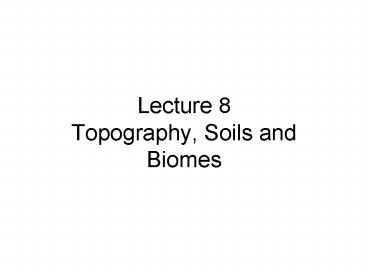Lecture 8 Topography, Soils and Biomes PowerPoint PPT Presentation
1 / 23
Title: Lecture 8 Topography, Soils and Biomes
1
Lecture 8Topography, Soils and Biomes
2
- Topography
- Rain shadows
- Riparian forests
- North/south orientation
3
- Soil
- What is it?
- Where does it come from?
- Factors affecting formation
- Parent material
- Biotic processes
- Climate
- Topography
- Time (age)
4
Soil Layers Horizons
5
- Nutrients and Soil Cation Exchange
- Cation positively charged
- Attracted to negatively charged soil
particles/organic matter - Binding of Cations cation exchange capacity ?
index of soil fertility - impacted by
- Soil age
- Parent material
- Water flow, precipitation, vegetation
- Podsolization
- Laterization
- pH
- Cation exchange priority
- Al3gtHgtCa2gtMg2gtKNH4gtNa
6
Acidic Bogs Special conditions - Plants from
acidic bogs
7
- Biomes
- Biome Major regional ecological community of
plants and animals - Climate zone system Heinrich Walter
- 9 major divisions see Fig 5.4
- Climate diagrams relate annual cycle of ppt and
temp. - Whittaker system based on vegetation type and
combined ppt/temp. factors - Worldwide in distribution
- Convergent evolution of adaptations
convergence
8
(No Transcript)
9
- 9 biomes and corresponding Climate zones - Walter
- Tropical rain forest
- Equatorial
- Tropical seasonal forest/savanna
- Tropical
- Subtropical desert
- Subtropical desert
- Woodland/shrub land
- Mediterrean
- Temperate rain forest
- Warm temperate
- Temperate seasonal forest
- Nemoral
- Temperate grassland/desert
- continental
- Boreal forest
- Boreal
- Tundra
- polar
10
- Climatogram
- Graphical representation of monthly mean
temperature and precipitation for a location - Enables rapid comparison of climatic factors of
different regions
11
- Climatogram
- Graphical representation of monthly mean
temperature and precipitation for a location - Enables rapid comparison of climatic factors of
different regions
12
(No Transcript)
13
- Limnology - study of inland waters
- Ecology of Freshwater Ecosystems
- Rivers, streams, lakes and wetlands
14
Lakes - Structure
- Structure
- Littoral zone Shallows
- Limnetic zone Open lake
- Epilimnion Warm surface layers.
- Metalimnion Temperature changes with depth.
- Hypolimnion Cold dark waters.
15
Lake Structure
16
Lakes - Physical Conditions
- Light
- Lake color depends on light absorption and
biological activity. - Temperature
- Lakes become thermally stratified as they warm.
- Water Movement
- Wind-driven mixing of the water column is
ecologically important.
17
Seasonal Temperature Changes
18
Lakes - Chemical Conditions
- Oxygen
- Oligotrophic Low biological production, although
often well oxygenated. - Eutrophic High biological production, but may be
depleted of oxygen.
19
Marine Environments
- Estuaries
- Marine Shores
- Shallow Marine Waters
- Oceans
20
Estuaries, Salt Marshes, and Mangrove Forests
- Estuaries are found where rivers meet the sea.
- Salt Marshes and Mangrove Forests are
concentrated along low-lying coasts. - All driven by ocean tides and river flow.
- Transport organisms, nutrients, oxygen, and
remove wastes. - Extremely vulnerable to human intrusion.
21
- Oceans Horizontal and Vertical Zones
- Vertical Zones (extending from the shore)
Littoral/Neritic/Oceanic - Horizontal Zones (by depth)
- Marine biologists have their own sense of
geography!
22
- Marine Systems Regions
- Littoral intertidal
- Wave action, intermittent drying, variations in
salinity - Benthic refers to sea bottom
- Neritic ocean over continental shelf -
100-200m - Oceanic Continental slope to open ocean
23
Neritic Zone Over continental shelf
Oceanic Zone From continental shelf to open
ocean

